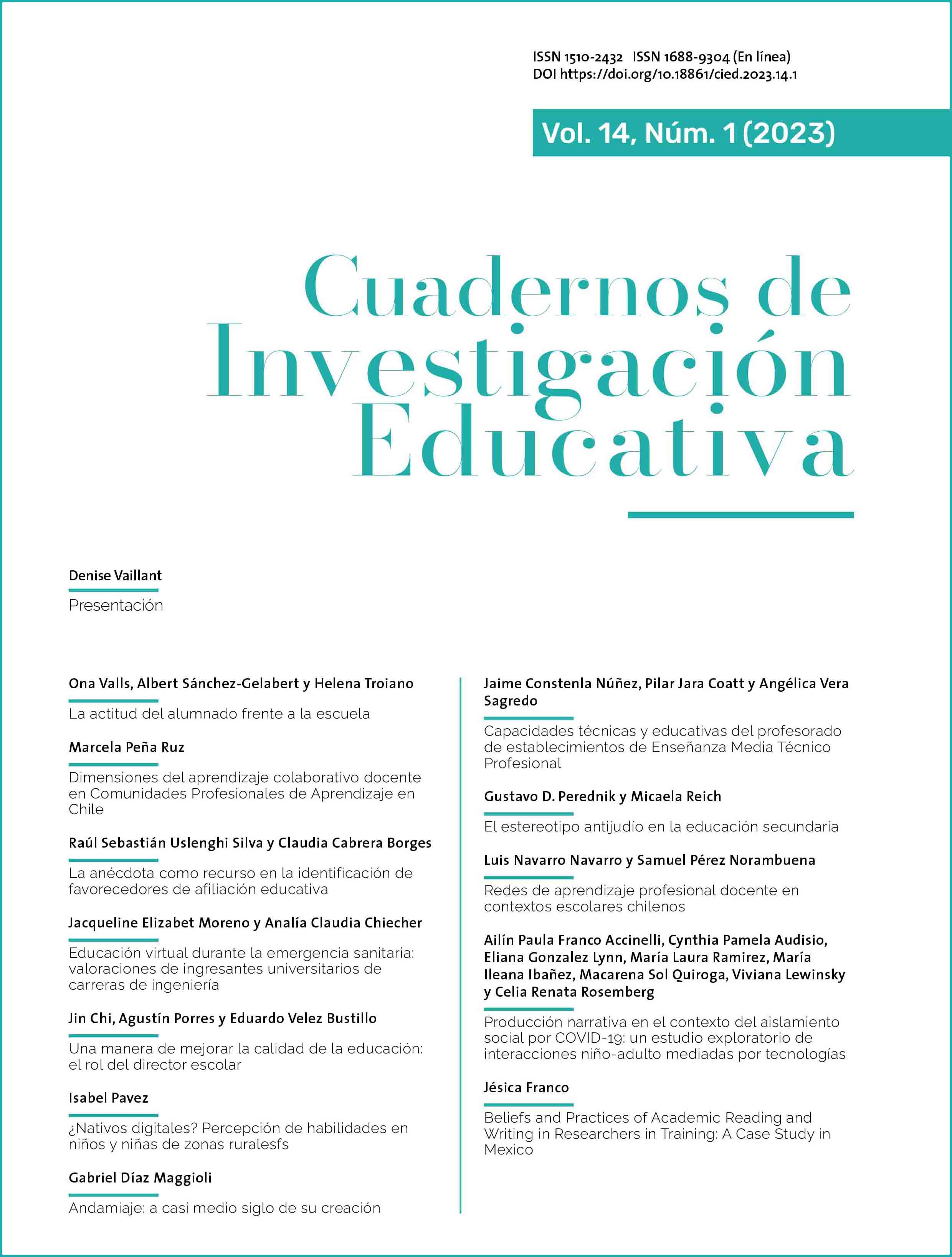Andaime: quase meio século depois da sua criação
DOI:
https://doi.org/10.18861/cied.2023.14.1.3251Palavras-chave:
mediação, andaime, Zona de Desenvolvimento Proximal, perspectiva sociocultural, metanálise, ensino, aprendizagemResumo
A metáfora do andaime foi originalmente cunhada na segunda metade do século XX para dar conta de una forma muito específica de suporte à aprendizagem. Desde a sua criação no campo educacional, evoluiu e foi usado para se referir a uma ampla variedade de construtos relacionados ao ensino e à aprendizagem. Devido à polissemia decorrente dessa situação, optou-se por realizar uma meta-análise da literatura sobre andaimes desde o seu surgimento até os últimos tempos. Os resultados da pesquisa confirmam a existência de diversas conceituações do termo e evidenciam a necessidade de se advogar por um posicionamento epistemológico específico para o mesmo, dada sua relevância para os campos de ensino e aprendizagem.
Downloads
Referências
Bickhard, M. (2005). Functional scaffolding and self-scaffolding. New Ideas in Psychology, 23, 166-173.
Bliss, J., Askew, M., & Macrae, S. (1996). Effective teaching and learning: Scaffolding revisited. Oxford Review of Education, 22(1), 37-61.
Botella, J. & Zamora, A. (2017). El metaanálisis: una metodología para la investigación en educación. Educación XXI 20(2), 17-38. https://doi.org/10.5944/educxx1.19030
Bruner, J., & Sherwoord, V. (1976). Peekaboo and the learning of rule structures. In J. Bruner, A. Jolly, & K. Sylva (Eds.), Play: Its role in development and evolution (pp. 277-287). Penguin Books.
Chaiklin, S. (2003). The Zone of Proximal Development in Vygotsky’s analysis of learning and instruction. In A. Kozulin, B. Gindis, V. Ageyev, & S. M. Miller (Eds.), Vygotsky’s educational theory in cultural context (pp. 39-64). Cambridge University Press.
Díaz Maggioli, G. (2013). Of metaphors and literalization: Reconceptualizing scaffolding in language teaching. Encounters/Encuentros/Rencontres on Education 14, pp. 133-150.
Díaz Maggioli, G. (2022). Initial Language Teacher Education. Routledge.
Feuerstein, R., Rand, Y., Hoffman, M., & Miller, R. (1980). Instrumental enrichment: An intervention program for cognitive modifiability. University Park Press.
Gibbons, P. (2002). Scaffolding language, scaffolding learning: Teaching Second Language Learners in the mainstream classroom. Heinemann.
Gibbons, P. (2003). Mediating language learning: Teacher interactions with ESL students in content-based classrooms. TESOL Quarterly, 37(2), 247-273.
Glass, G. V., McGraw, B., & Smith, M. L. (1981). Meta-analysis of social research. Sage.
Guba, E. G., & Lincoln, Y. S. (1994). Competing paradigms in qualitative research. In Denzin, N.K. & Lincoln, Y.S. (Eds.), Handbook of qualitative research (pp. 105 - 117). Sage Publications, Inc.
Hammond, J., & Gibbons, P. (2005). Putting scaffolding to work: The contribution of scaffolding in articulating ESL education. Prospect, 20(1), 6-30.
Holton, D., & Clarke, D. (2006). Scaffolding and metacognition. International Journal of Mathematical Education in Science and Technology, 37(2), 127-143.
Johnson, K. E. (2009). Second language teacher education: A sociocultural perspective. Routledge.
Kozulin, A. (1998). Psychological tools: A sociocultural approach to education. Harvard University Press.
León Hernández, S. R., & Aguilera Zepeda, J. M. (2001). Metodología de los estudios de metaanálisis en la investigación clínica. Revista Mexicana de Ortopedia Traumática, 15(2), 86-91.
Littleton, K. & Mercer, N. (2013). Interthinking: Putting talk to work. Routledge.
Mason, J., 2002. Researching your own practice: The discipline of noticing. Routledge.
Mercer, N. & Howe, C. (2012). Explaining the dialogic processes of teaching and learning: The value and potential of Sociocultural theory. Learning, Culture and Social Interaction, 1(1), 12-21.
Mercer, N. (2000). Words & Minds: How we use language to think together. Routledge.
Mercer, N. (2004). Sociocultural discourse analysis: Analysing talk as a social mode of thinking. Journal of Applied Linguistics, 1(2), 137-168.
Poehner, M. E. (2010). Dynamic assessment: A Vygotskian approach to understanding and promoting L2 development. Springer.
Poehner, M. E., & Lantolf, J. P. (2005). Dynamic assessment in the language classroom. Language Teaching Research, 9(3), 233-265.
Saldaña, J. (2013). The coding manual for qualitative researchers. Sage.
Sharpe, T. (2006). “Unpacking” scaffolding: Identifying discourse and multimodal strategies that support learning. Language and Education, 20(3), 211-231.
Sherin, B., Reiser, J., & Edelson, D. (2009). Scaffolding analysis: Extending the scaffolding metaphor to learning artifacts. Journal of the Learning Sciences, 13(3), 387-421.
Shrum, J. L., & Glisan, E. W. (2010). Teacher’s Handbook: Contextualized Language Instruction. Cengage Learning.
Swain, M., Kinnear, P., & Steinman, L. (2011). Sociocultural theory in second language education: An introduction through narratives. Multilingual Matters.
Vaillant, D. & Marcelo, C. (2021). Formación inicial del profesorado: Modelo actual y llaves para el cambio. REICE. Revista Iberoamericana sobre Calidad, Eficacia y Cambio en Educación, 19(4), 55-69. https://doi.org/10.15366/reice2021.19.4.003
Vélez-Ibáñez, C. G., & Greenberg, J. B. (1992). Formation and transformation of funds of knowledge. Anthropology and Education Quarterly, 23, 313-335.
Verenikina, I. (2004). From theory to practice: What does the metaphor of scaffolding mean to educators today? Outlines, 2, 5-15.
Viada González, C., Fors López, M., Ballesteros, J., Álvarez Cardona, M., Frías Blanco, A. & García Fernández, L. (2018). Metodología y sistemas para el metaanálisis de ensayos clínicos. Revista Cubana de Informática Medica, 10(2). http://www.revinformatica.sld.cu/index.php/rcim/article/view/306
Vygotsky, L. S. (1978). Mind in society: The development of higher psychological processes. Harvard University Press.
Vygotsky, L. S. (1987). The collected works of Lev S. Vygotsky. Volume I: Problems of General Psychology. Plenum Press.
Walqui, A. (2006). Scaffolding instruction for English Language Learners: A conceptual framework. International Journal of Bilingual Education and Bilingualism, 9(2), 159-180.
Walqui, A., & van Lier, L. (2010). Scaffolding the academic success of adolescent English Language Learners. WestEd.
Wood, D., Bruner, J., & Ross, G. (1976). The role of tutoring in problem solving. Journal of Child Psychology and Psychiatry, 17, 89-100.
Publicado
Como Citar
Edição
Seção
Licença

Este trabalho está licenciado sob uma licença Creative Commons Attribution 4.0 International License.





